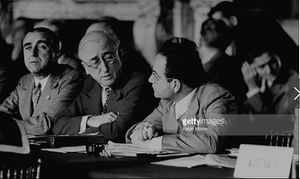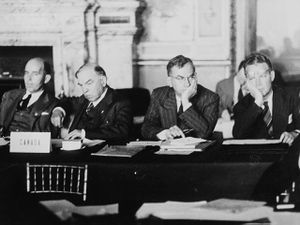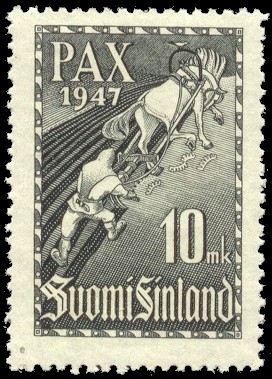معاهدات پاريس للسلام 1947
| Paris Peace Treaties, 1947 | |
|---|---|
 الوفد الأمريكي يحضر لجنة الإجراءات في مؤتمر پاريس للسلام، قصر لوكسمبورگ. (من اليمين لليسار:) بنجامن ڤ. كوهن، جيمس ف. بيرنز، جيمس ك. دن. 1 أغسطس 1946. | |
| النوع | معاهدات متعددة الأطراف |
| وُقـِّعت | 10 فبراير 1947 |
| المكان | پاريس، فرنسا |
| الموقعون الأصليون | المملكة المتحدة، الولايات المتحدة، الاتحاد السوڤيتي، فرنسا، إيطاليا، رومانيا، المجر، بلغاريا، فنلندا |
| المصدقون | المملكة المتحدة، الاتحاد السوڤيتي، الولايات المتحدة، فرنسا، إيطاليا، رومانيا، المجر، بلغاريا، فنلندا |
مؤتمر باريس للسلام (29 يوليو حتى 15 أكتوبر 1946) أسفرت عن معاهدات باريس للسلام الموقعة في 10 فبراير 1947. القوى المتحالفة المنتصرة في وقت الحرب (خاصة الولايات المتحدة، الاتحاد السوڤيتي، المملكة المتحدة، وفرنسا) ناقشت تفاصيل المعاهدات مع إيطاليا، رومانيا، المجر، بلغاريا، وفنلندا (انظر قائمة البلدان المشاركة في الحرب العالمية الثانية).

سمحت المعاهدات لإيطاليا، رومانيا، المجر، بلغاريا، وفلندا بإستعادة مسئولياتها كدول سيادية في العلاقات الدولية وبالتأهل لعضوية الأمم المتحدة.
التسوية الواردة في معاهدات السلام تضمنت دفع تعويضات الحرب، الإلتزام بحقوق الأقلية والتعديلات الاقليمية وإنهاء الامبراطورية الاستعمارية الإيطالية في أفريقيا، اليونان وألبانيا والتغيرات في الحدود الإيطالية-اليوغسلاڤية، المجرية-السلوڤاكية، الرومانية-المجرية، السوڤيتية-الرومانية، البلغارية-الرومانية، الفرنسية-الإيطالية، والسوڤيتية-الفنلندية.
البنود السياسية الواردة والتي يجب عليها "تأخذ جميع معايير الحاجة لتأمين جميع الأشخاص تحت ولايتها القضائية، دون التمييز على أساس العرق، الجنس، اللغة أو الديانة، التمتع بحقوق الإنسان وبالحريات الأساسية، وتشمل حرية التعبير، الإعلام والنشر، دور العبادة، الرأي السياسي واللقاءات العامة".
لم تفرض عقوبات على المواطنين الذين تم زيارتهم بسبب شراكة الحلفاء وقت الحرب. كل حكومة تلتزم بالمعايير لمنع عودة تنظيمات الفاشية أو أي تنظيمات أخرى سواء كانت سياسية، عسكرية أو شبه عسكرية، التي تهدف إلى حرمان الشعوب من حقوقها الديمقراطية".
خاصة في فنلندا، كان ينظر للتعويضات وتعديل الحدود التي أملتها معاهدات باريس على أنها ظلم بين وخيانة من القوى الغربية، بعد التعاطف الذي حصلت عليه فنلندا من الغرب أثناء حرب الشتاء التي شنها السوڤييت عام 1939-1940. ومع ذلك، فقد تلاشى هذا التعاطف بتعاون فنلندا مع ألمانيا النازية أثناء سنوات الحرب من 1941-1944. في ذلك الوقت لم تكتف فنلندا فقط باستعادة أراضيها التي خسرتها عام 1940، لكنها أيضاً استمرت في هجومها داخل العمق السوڤيتي، لتحتل شريط قطاع واسع من الأراضي السوڤيتية. شجع هذا المملكة المتحدة على إعلان الحرب على فنلندا في ديسمبر 1941، والمزيد من الضعف السياسي الواهن من الغرب لهذا البلد. استيلاء الاتحاد السوڤيتي على الأراضي الفنلندية كان معتمداً على هدنة موسكو الموقعة في موسكو في 19 سبتمبر 1944 وأسفرت عن توسع الاستحواذات في معاهدة موسكو للسلام (1940) التي أنهت حرب الشتاء.
الفقرات السياسية
The political clauses stipulated that the signatory should "take all measures necessary to secure to all persons under (its) jurisdiction, without distinction as to race, sex, language or religion, the enjoyment of human rights and of the fundamental freedoms, including freedom of expression, of press and publication, of religious worship, of political opinion and of public meeting."
No penalties were to be visited on nationals because of wartime partisanship for the Allies. Each government undertook measures to prevent the resurgence of fascist organizations or any others "whether political, military or semi-military, whose purpose it is to deprive the people of their democratic rights".
التغييرات في الحدود
- إيطاليا فقدت مستعمراتها؛ شرق أفريقيا الإيطالي (يتكون من إثيوپيا، إرتريا والصومال الإيطالي) وليبيا الإيطالية في شمال أفريقيا. في معاهدة السلام اعترفت إيطاليا باستقلال ألبانيا (في ظل اتحاد شخصي مع الملكية الإيطالية بعد الغزو الإيطالي لألبانيا في أبريل 1939). فقد إيطاليا أيضاً امتيازاتها في تيانجين والتي تنازلت عليها إيطاليا لجمهورية الصين. تنازلت إيطاليا عن معظم إستريا، وشملت مقاطعات فيومه، زارا ومعظم گوريزيا وپولا إلى يوغسلاڤيا. بقية مقطاعة پولا بالإضافة إلى ريسته انفصلت لتشكل أراضي تريسته الحرة والتي تنازلت عنها لليونان. الحدود مع فرنسا عدلت قليلاً لصالح فرنسا، معظم منطقة الألپ غير المأهولة، عدا وادي تند ولا بريج. الأراضي التي فقدتها إيطاليا شملت المناطق التي كانت جزءاً من إيطاليا قبل الحرب العالمية الثانية، وكذلك مناطق كانت قد استولت عليها قبل مجيء النظام الفاضي عام 1922 (مثل ليبيا، والتي استولت عليها عام 1922).
- فنلندا استعادت حدودها في 1 يناير 1941 (مؤكدة بذلك الأراضي التي خسرتها بعد حرب الشتاء)، عدا المقاطعات السابقة في پستامو، والتي تنازلت عنها للاتحاد السوڤيتي.
- المجر استعادت حدود ما قبل الحرب، (جوائز ڤيينا أعلن عن بطلانها، مما ألغى مكاسب المجر في تشيكوسلوڤاكيا ورومانيا) عدا ثلاثة قرى في جنوب براتيسلاڤا، والتي انتقلت إلى تشيكوسلوڤاكيا.
- رومانيا استعادت حدود 1 يناير 1941، عدا الحدود مع المجر، التي تغيرت إلى حدود ما قبل الحرب. يؤكد هذا خسائر 1940 في بسارابيا وبوكوڤينا الشمالية لصالح الاتحاد السوڤيتي ومعاهدة كرايوڤا، والتي أعادت دوبرويا الجنوبية لبلغاريا.
- بلغاريا استعادت حدود 1 يناير 1941، مما جعل بلغاريا هي الوحيدة من بين القوى السابقة التي فازت بأراضي بعد الحرب العالمية الثانية.
إيطاليا
Italy lost the colonies of Italian Libya and Italian East Africa. The latter consisted of Italian Ethiopia, Italian Eritrea, and Italian Somaliland. Italy continued to govern the former Italian Somaliland as a UN trust territory until 1960. In the peace treaty, Italy recognized the independence of Albania (in personal union with the Italian monarchy after the Italian invasion of Albania in April 1939). Italy also lost its concession in Tianjin, which was turned over to China, and the Dodecanese Islands in the Aegean Sea were ceded to Greece.
Italy lost Istria: the provinces of Fiume, Zara, and most of Gorizia and Pola were ceded to Yugoslavia; the rest of Istria and the province of Trieste formed a new sovereign State (Free Territory of Trieste) divided in two administrative zones under a provisional government for which the United Nations Security Council was responsible.[1][2] In 1954, Italy incorporated the Province of Trieste (Zone A) and Yugoslavia incorporated the rest of Istria (Zone B). This was officially recognized with the Treaty of Osimo in 1975.
The villages of the Tende valley and La Brigue were ceded to France but Italian diplomats were able to maintain in place the Treaty of Turin (1860), according to which the French-Italian alpine border passes through the summit of Mont Blanc, despite French designs on the Aosta Valley. The French Republic has never made provision for the Italian language in the ceded formerly Italian towns of Briga and Tenda, effectively opting for a policy of linguistic assimilation.[3] The province of South Tyrol was also kept by Italy despite the territorial demands of Austria, largely thanks to the Gruber–De Gasperi Agreement signed some months before.
فنلندا
Finland was restored to its borders of 1 January 1941 (thus confirming its territorial losses after the Winter War of 1939-1940), except for the former province of Petsamo, which was ceded to the Soviet Union. In Finland, the reparations and the dictated border adjustment were perceived as a major injustice and a betrayal by the Western powers, after the sympathy Finland had received from the West during the Soviet-initiated Winter War. However, this sympathy had been eroded by Finland's collaboration with Nazi Germany between 1941 and 1944. During this time, Finland not only recaptured territory it had lost in 1940, but continued its offensive deeper into Soviet lands, occupying a broad strip of Soviet territory. This prompted the United Kingdom to declare war on Finland in December 1941, further weakening political support in the West for the country. The Soviet Union's accessions of Finnish territory was based on the Moscow Armistice signed in Moscow on 19 September 1944 and resulted in an extension of the accessions in the Moscow Peace Treaty that ended the Winter War.
المجر
Hungary was restored to its borders before 1938. This meant restoring the southern border with Yugoslavia, as well as declaring the First and Second Vienna Awards null and void, cancelling Hungary's gains from Czechoslovakia and Romania. Furthermore, three villages (namely Horvátjárfalu, Oroszvár, and Dunacsún) situated south of Bratislava were also transferred to Czechoslovakia, in order to form the so-called "Bratislava bridgehead".
رومانيا
Romania was restored to its borders of 1 January 1941, with the exception of the border with Hungary giving Northern Transylvania back to Romania. This confirmed the 1940 loss of Bessarabia and Northern Bukovina to the Soviet Union and the Treaty of Craiova, which returned Southern Dobruja to Bulgaria.
بلغاريا
Bulgaria was restored to its borders of 1 January 1941, returning Vardar Macedonia to Yugoslavia and Eastern Macedonia and Western Thrace to Greece, but keeping Southern Dobruja per the معاهدة كرايوڤا، leaving Bulgaria as the only former Axis power to keep territory that was gained during the Second World War.[4]
تعويضات الحرب
The war reparation problem proved to be one of the most difficult arising from post-war conditions. The Soviet Union, the country most heavily ravaged by the war, felt entitled to the maximum amounts possible, with the exception of Bulgaria, which was perceived as being the most sympathetic of the former enemy states. (Bulgaria was part of the Axis but did not declare war on the Soviet Union). In the cases of Romania and Hungary, the reparation terms as set forth in their armistices were relatively high and were not revised.
War reparations at 1938 prices, in United States dollar amounts:
تعويضات الحرب عام 1938، بالدولار الأمريكي:
- 360.000.000 من إيطاليا
- 125.000.000 إلى يوغسلاڤيا؛
- ،105.000.000 إلى اليونان؛
- 100.000.000 إلى الاتحاد السوڤيتي؛
- 25.000.000 إلى إثيوپيا؛
- 5.000.000 إلى ألبانيا.
- 300.000.000 من فنلندا إلى الاتحاد السوڤيتي؛
- 300.000.000 من المجر:
- 200.000.000 إلى الاتحاد السوڤيتي؛
- 100.000.000 إلى تشيكوسلوڤاكيا ويوغسلاڤيا.
- 300.000.000 من رومانيا إلى الاتحاد السوڤيتي؛
- 70.000.000 من بلغاريا:
الأعقاب
The dissolution of the Soviet Union and Yugoslavia in the early 1990s did not lead to any renegotiation of the Paris Peace Treaties. However, in 1990 Finland unilaterally cancelled the restrictions the treaty had placed on its military.[5]
انهيار الاتحاد السوڤيتي لم يؤد لأي تعديل رسمي لمعاهدات باريس للسلام.
انظر أيضاً
- ما بعد الحرب العالمية الثانية
- لجنة الحلفاء
- اتفاقية پوستدام (1945)
- مؤتمر موسكو (1945)
- معاهدات السلام مع إيطاليا 1947
- معاهدة التسوية النهائية بشأن ألمانيا
- الاحتلال السوڤيتي لألمانيا
- تجهيزات الحرب العالمية الثانية تجاه يوغسلاڤيا
وصلات خارجية
- United States Department of State Foreign relations of the United States, 1946. Paris Peace Conference Proceedings
- United States Department of State Foreign relations of the United States, 1946. Paris Peace Conference Documents
- Australian treaty series 1948 (النص الكامل للمعاهدات).
- "Paris-WWII Peace Conference-1946: إرساء حدود رومانيا الغربية", في القنصلية الفخرية لرومانيا في بوسطن، فيه صور لوفد رومانيا.
- ^ Article 21 and Annex VII, Instrument for the Provisional Regime of the Free Territory of Trieste
- ^ United Nations Security Council 16, 10 January 1947
- ^ Redazione (2017-11-22). "Bilinguismo: la discussione a Fiume potrebbe aprire il dibattito anche a Briga e Tenda". Corsica Oggi (in الإيطالية). Retrieved 2019-10-15.
- ^ Treaty of Peace with Bulgaria, Dated February 10, 1947, Paris. Treaties and other international acts series ;1650. Washington: United States Government Printing Office. 1947. hdl:2027/umn.31951002025850d.
- ^ "NATO Review - No. 1 - Feb 1993".
- Missing redirects
- ما بعد الحرب العالمية الثانية
- 1947 في فنلندا
- 1947 في بلغاريا
- 1947 في رومانيا
- 1947 في إيطاليا
- 1947 في الاتحاد السوڤيتي
- العلاقات البلغارية السوڤيتية
- العلاقات الفنلندية السوڤيتية
- العلاقات المجرية السوڤيتية
- الإيطالية السوڤيتية
- العلاقات الإيطالية اليوغسلاڤية
- العلاقات الرومانية السوڤيتية
- معاهدات سلام بلغارية
- معاهدات سلام فنلندية
- معاهدات سلام فرنسية
- معاهدات سلام مجرية
- معاهدات سلام إيطالية
- معاهدات سلام سوڤيتية
- معاهدات سلام بريطانية
- معاهدات سلام أمريكية
- معاهدات ابرمت في 1947
- معاهدات دخلت حيز التنفيذ في 1947
- معاهدات الجمهورية الفرنسية الرابعة
- معاهدات إيطاليا
- معاهدات مملكة رومانيا
- معاهدات جمهورية بلغاريا الشعبية
- معاهدات يوغسلاڤيا
- معاهدات الحرب العالمية الثانية
- القرن 20 في باريس
- CS1 الإيطالية-language sources (it)
